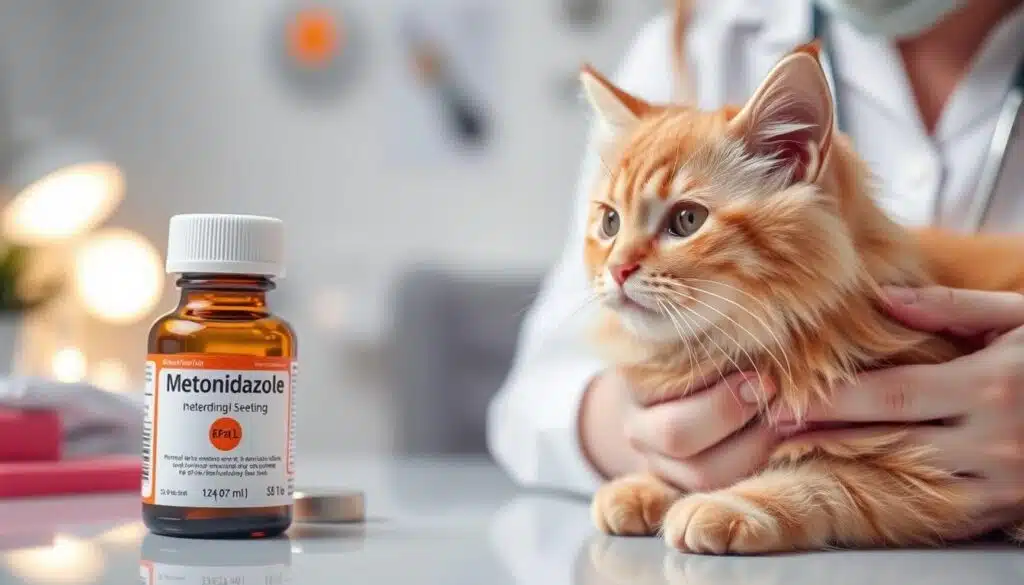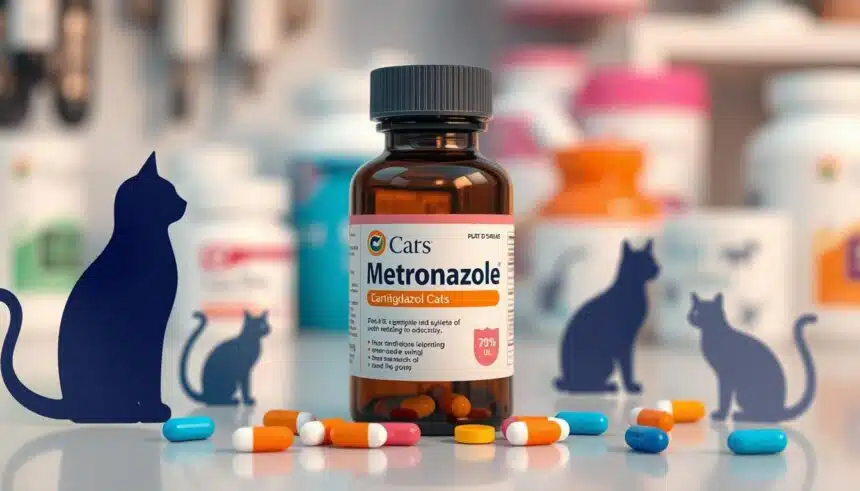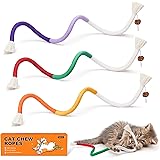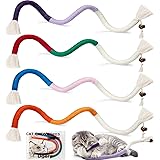As a cat owner, have you ever wondered about Metronidazole? This antibiotic is often given to cats. But do you know why and how to use it right? Learning about Metronidazole could help you care for your cat better.
Key Takeaways
- Metronidazole is an antibiotic and antiprotozoal medication commonly used to treat infections in cats.
- It is effective against certain types of bacteria and protozoa parasites, particularly those affecting the digestive tract.
- Metronidazole is not FDA-approved for use in animals, but veterinarians can legally prescribe it as an extra-label or off-label medication.
- Proper dosage and administration guidelines are crucial to ensure the safe and effective use of Metronidazole for cats.
- Understanding the potential side effects and contraindications associated with Metronidazole is essential for responsible pet ownership.
Understanding Metronidazole and Its Uses in Cats
Metronidazole is a key medication for cats with many health issues. It fights bacteria and parasites, though it’s not FDA-approved for cats. Yet, vets use it because it’s effective.
What is Metronidazole?
Metronidazole fights anaerobic bacteria and some parasites. It kills or stops these microbes by messing with their DNA and cells.
Common Medical Applications
Vets often give metronidazole to cats for several reasons. It helps with:
- Digestive problems like diarrhea and inflammatory bowel disease
- Urinary tract infections
- Skin and respiratory infections
- Liver disease and gum infections
- Some cancers, helping slow tumor growth
Metronidazole is great because it tackles both bacteria and parasites. It also has anti-inflammatory effects, helping with many cat health issues.
MeoHui Cat Toys for Indoor Cats, Interactive Cat Toy 2PCS Retractable Wand Toy and 9PCS Cat Feather Toys Refills, Funny Kitten Toys Cat Fishing Pole Toy for Bored Indoor Cats Chase and Exercise
PetPivot Self Cleaning Litter Box, Open Top Automatic Litter Box for Multiple Cats, Multiple Layer Safety Protection, Liners and Mat Included, White
30% OffYaheetech Large Multi-Level Cat Tree, 63 Inches Tall with Sisal-Covered Scratching Posts, Condo, Hammock, Dangling Ball, and Extended Platform for Cats to Play and Sleep
Hdwk&Hped Soft Cotton Dog Pajamas for All Seasons, Striped Pet Bottoming Jumpsuit for Small Dog Cat Puppy (#1, Striped Style – 2-Pack(red&Dark Green))
TP-Link Tapo 1080P Indoor Security Camera for Baby Monitor, Dog Camera w/Motion Detection, 2-Way Audio Siren, Night Vision, Cloud & SD Card Storage, Works w/Alexa & Google Home (Tapo C100)
Catstages Crunchy Pickle Kicker Cat Toy – Plush Crinkle Toy with Catnip and Dental Mesh, 6.5″
Vital Essentials Minnows Cat Treats, 0.5 oz | Freeze-Dried Raw | Single Ingredient | Grain Free, Gluten Free, Filler Free
Fresh Step Clumping Cat Litter, Multi-Cat, Long Lasting Odor Control Kitty Litter with Activated Charcoal, Low Dust Formula, 14 lb
KEYHELP Pet Hair Removal Glove for Dogs & Cats, Newly Upgraded Reusable Electrostatic Pet Hair Glove, Pet Hair Remover Tool for Clothing, Couch, Carpet, Car Seat
Potaroma Cat Toys Chew Ropes 3Pcs with Refillable Natural Catnip, Safe Teeth Cleaning Toy for Indoor Kittens, Interactive Cat Nip Kitty Toys for All Breeds 19.5 Inches
FDA Status for Veterinary Use
Even though the FDA doesn’t approve metronidazole for cats, vets can still prescribe it. They use their knowledge to decide the right dose for each cat.
How Metronidazole for Cats Works
Metronidazole is a strong antibiotic and antiprotozoal for cats. It fights anaerobic bacteria and protozoa, which don’t need oxygen. When it gets into these cells, it messes with their DNA.
This messes up their DNA, stopping them from making new cells. This leads to their death. It’s a powerful way to fight infections in cats.
Metronidazole is great for treating many issues in cats. It stops harmful organisms from growing and spreading. This lets the cat’s immune system take over and heal.
It’s important to give metronidazole with food for it to work best. Following the vet’s dosage instructions is key. This helps avoid side effects like neurological problems or liver issues.
Vets often use metronidazole off-label, showing they trust it. Knowing how it works helps pet owners understand its role in keeping their cats healthy. Always follow your vet’s advice when using it.
Common Conditions Treated with Metronidazole
Metronidazole is a key medication in veterinary care for cats. It fights off bacterial and protozoal infections. It also helps with inflammatory bowel disease.
PAYHTOW 2 Pack Cat Christmas Sweater, Knit Turtleneck Cat Sweater Clothes Reindeer Santa Christmas Sweaters Outfit for Cats Kitten Puppy Small Dogs XS
Qraxond Interactive Cat Toys for Indoor Cats,[Newly Upgraded] Rechargeable Touch Activated Hide and Seek Kitten Toys for Bored Indoor Adult Cats with Fluttering (Blue)
ANYSENT Interactive Chirping Bird Cat Toy,2025 New Flying Bird Cat Toy Flapping Bird Toy,Simulation Chirping Bird Toys Interactive Cat Toys for Bored Indoor Adult Cats (Blue/1PCS)
$36.99 (as of December 23, 2025 16:27 GMT +00:00 – More infoProduct prices and availability are accurate as of the date/time indicated and are subject to change. Any price and availability information displayed on [relevant Amazon Site(s), as applicable] at the time of purchase will apply to the purchase of this product.)Sheba Perfect Portions Wet Cat Food Cuts in Gravy, Roasted Chicken Entree, with Sustainable Salmon, Tender Turkey Entree, 2.6 oz. Twin-Pack Trays (24 Count, 48 Servings)
INABA Churu Cat Treats, Lickable, Squeezable Creamy Purée Cat Treat with Taurine & Green Tea Extract, 0.5oz Each Tube, 12 Tubes, Churu Spoon Holiday Variety Pack
Temptations Classic Crunchy and Soft Cat Treats Tasty Chicken Flavor, 30 oz. Tub
Retro Shaw Cat Toys, 11 in Realistic Catnip Snake Toy with Crinkle Sound Inside, Cat Nip Toys with SilverVine, Stuff Snake Interactive Snake Toy for Cats to Chew
Dgerp Cat Chew Ropes 4Pcs, Cat Toys for Indoor Cats with Refillable Natural Catnip, Safe Teeth Cleaning Chew Toys, Interactive Kitten Nip Toys and All Breeds (19.5 Inches)
Cat Vitamin Treats with L-Lysine & Taurine – 12 Essential Vitamins & 5 Minerals, Cat Multivitamin Supplement for Immune, Joint & Skin Support, Daily Health Formula for Indoor & Senior Cats – 450 Chews
Saolife Laser Cat Toys for Indoor Cats, Truly Random Trjajectory, Suction Cup Design, Run Quiet, Interactive Cat Toy Automatic
Bacterial Infections
Metronidazole targets anaerobic bacteria like Clostridium and Bacteroides. These bacteria can cause stomach problems in cats. The drug kills the infection and relieves symptoms.
Protozoal Infections
Metronidazole is a go-to for giardiasis, a parasitic infection. It’s caused by Giardia duodenalis. The drug cuts down on cysts and stops diarrhea.
Inflammatory Bowel Disease
Metronidazole is also for inflammatory bowel disease (IBD) in cats. Its exact how-it-works is still a mystery. But it reduces inflammation and helps manage symptoms like diarrhea and weight loss.
Remember, metronidazole is a powerful tool but should only be used as a vet advises. The right dose and careful monitoring are key to its safe use in cats.
Proper Dosage and Administration Guidelines
The metronidazole dosage for cats depends on their weight and the illness. It’s usually given by mouth and can be with or without food. Vets adjust the dose based on the infection’s severity and how the cat responds.
In some cases, metronidazole compounded for cats is suggested. This makes it easier to give and meets specific needs. Compounded formulas are customized for each cat, ensuring the right amount is given.

- 🐱 【Multifunctional Activity Center】The cat Tree provides 3 top perches platforms and two cozy condo. Whether your kitten wants to stretch out on a spacious perch, curl up in a plush hole room, or release the urge to scratch on a sisal pole, this multifunctional cat tree tower works perfectly as a recreation paradise,which can make your fur baby's day full of fun and excitement!two toys gives them a unique way and Fun to play!
- 🐱【 Large Space Vertical】Because of its compact footprint and ability to conserve floor space, the cat tree design offers a large amount of vertical space. Every cat can have their own zone thanks to the cat jumping platform, which is another way that modern cat trees promote indoor cat peace. Maximum Load Capacity: 44 lbs. If your cat is too big for this cat tree, please buy one for tiny and medium-sized cats!
- 🐱 【Stable Construction】Our Cat Tower is made of high-quality particle board with skin friendly plushy faux-fur cover to keep your cat warm and comfortable. The cat activity tree has a wall anchor strap which provides a good double security protection. You don't have to worry that the cat tree will overturn or shake accidentally.Give your cat the best protection!ideal for average kittens and cats.
- 🐱 【Posts for Scratching Covered in Sisal 】These are scratching surfaces that are integrated into the framework. Cats love to bury their claws in sisal because it's a sturdy substance with a coarse texture. Our cat tree promotes healthy scratching habits and helps discourage cats from damaging furniture by offering dedicated spaces for them to scratch.
- 🐱 【Simple assembly】We understand that convenience is important to pet owners, which is why we made our cat tree simple to assemble in a matter of minutes. You can quickly provide your kitties a stimulating environment by following the simple setup instructions and using the available tools. Please feel free to contact us with any questions you may have about our cat tree, and we will respond to you within a day!

- Teething Fun: Ideal for kittens and cats alike, these chew toys are an essential addition to your kitty’s dental care. With natural gall fruit and rope design, the toys are perfect for teething and teeth cleaning, they combat tartar and freshen breath, making dental hygiene a fun activity for your little one!
- Infused with Catnip Aroma: The included catnip bag emits a soothing aroma that's irresistible to felines, ensuring these toys are a calming and engaging presence for indoor play. Our cat toys provide the calming, meow-inducing fun every kitten craves, along with a funny and interactive experience.
- Energetic Exercise: Promote healthy exercise and self-play with our toys' appealing textures and tassels. They’re designed to entice your kitty to bite and play aggressively without harm, offering hours of exercise and self-amusement, keeping your cat active and happy.
- Quiet Play: These soft colorful ropes provide enriching quiet playtime without bothering cat owner's sleep or life. Your kitty will love the funny snake-like shapes, enhancing their playtime with every pounce and bite.
- Safe and Organic: These chew toys, handcrafted without any metal wire and using organic cotton rope, are safe for all cats. Paired with a reusable catnip bag, they’re an essential, eco-friendly addition to your cat’s enrichment collection.

- MADE WITH WHOLESOME INGREDIENTS YOU CAN TRUST: Every Inaba product is made with yummy ingredients including farm-raised chicken and/or wild-caught tuna
- KEEP OUR FELINE HYDRATED WITHOUT ADDING CALORIES: Each delicious, creamy Churu tube contains 91% moisture and only 6 calories (a tenth of the calories of traditional dry cat treats), which makes it a healthy snack you can feel good about feeding
- FREE OF THE BAD STUFF: Your feline friend is important to us, which is why we've kept things like grains, preservatives, artificial colors and carrageenan out of our cat treats, but we added things like Vitamin E for immunity
- HAVE THEM EATING OUT OF YOUR HAND: These lickable purée meat tubes for cats were designed to be fed by hand, as an interactive way to spend time with your feline, but you can use as a wet/dry cat food topper or as a way to disguise medication
- ADD SOME VARIETY TO YOUR CAT'S LIFE: Available in eleven savory flavors, cats of all stages (kitten to senior) will be able to find a flavor they love

- FREEZE-DRIED RAW MINNOWS CAT TREAT: Vital Essentials Freeze Dried Cat Treats pack more protein than industry standard into every bite to deliver the peak vitality your dog deserves. Our natural freeze-dried raw cat treats are made from responsibly sourced premium minnows.
- BETTER PROTEIN = BETTER BENEFITS: The best freeze dried cat treats on the market use premium butcher cut raw protein to unlock the benefits of naturally occurring vitamins and minerals in raw muscle and organs, because pets deserve the energetic playtimes, healthy skin, shiny coats, strong teeth, and essential gut health that a high-protein diet delivers.
- PROUDLY AMERICAN CRAFTED: All our cat treats and food are responsibly sourced and humanely harvested to ensure the quality of our proteins. We go above industry standards to preserve flavor and ensure the highest quality of protein and nutrients in every Vital Essentials product.
- MADE WITHOUT: Cat treat additives, fillers, dyes, flavorings, artificial preservatives, grains, or rendered by-products. Vital Essentials also offers the widest variety of single-protein raw cat food and treats on the market—great for picky eaters and cats with allergies!
- RAW CAT TREATS FREEZE DRIED FOR PEAK FRESHNESS: Our protein is frozen within 45-minutes of harvesting to lock in peak nutrients, flavor, and freshness. A slow-freeze-dry ensures minimal processing, while preserving the vital nutrients that our pets deserve, the way nature intended.

- Cats Lose Their Cool: Just shake the pack, and your favorite feline will come running for their favorite cat treats
- Purr-fect Texture: Cat treats are crunchy on the outside and soft on the inside, making it the cat snack that keeps them coming back
- Under 2 Calories Per Treat: Each cat treat is under 2 calories, so these little crunchy goodies make the perfect snack or reward that can be given daily
- Trifecta of Tempting Cat Treats: Catnip Fever is a delicious cat snack with a mix of chicken, catnip, and cheese flavors your cat will love
- Value-Sized, Resealable Tub: Treat ’em again and again using the resealable tub that is perfect for keeping cat paws off when you’re not watching

- Award-Winning Product. Veken is proud to be a 2024 Category Winner of the Pet Innovation Awards, an honor given to only the most forward-thinking products within the rapidly expanding Pet industry.
- Upgraded Stainless Steel. Opt for a stronger, more hygienic version of our best selling pet fountain. Easy to clean and BPA-free, our stainless steel design offers the elevated and modern look you want with additional benefits.
- Large Capacity Water Tank. Worry less about your furry friend running out of water. Our pet fountain features a generously sized water reserve tank to help you avoid frequent refilling, ensuring your pets are healthy, hydrated, and happy.
- Advanced 5-Stage Filtration. Our upgraded system with silver, scale inhibitors, and activated carbon delivers fresh, clean water for up to 3 weeks. For optimal performance and your pet’s health, we recommend using softened or filtered water.
- LED Light Feature. Illuminate your pet’s favorite drinking spot with our optional on/off light feature. Designed for assisted visibility of water level and fountain location, our gentle light is perfect for avoiding spills and easy refilling.

- 4-in-1 Monitoring Tools: Sealed, hygienic strips for comprehensive cat wellness indicator checks.
- Simple At-Home Use: User-friendly steps with clear guidance—no professional training needed.
- Quick Readings: Obtain consistent readings at home in 10-20 minutes to stay attentive to your cat’s needs.
- Gentle and Non-Intrusive: Designed for minimal stress, using easy sample collection (feces/swabs) suitable for cats.
- Hygienic Components: Individually sealed tools and pre-measured solution for clean, safe use at home.

- 【Interactive Cat Toys】High quality aluminum alloy shell which equipped with metal clip design and three adjustment modes, only need to slide adjustment, no need to long press,in addition,Interactive cat toys mini size and easy to carry, easily put this cat toys in your pocket or bag, use it anytime and anywhere for added.
- 【7 In 1 Modes】This cat toys has 5 patterns: red dot, mice, butterfly, smile face, star. Scoll the black gear on the head to change to 3 different modes: red, purple, white. You can use the purple to check couterfeit currency and check your pets. White mode can be used for emergency lighting. The red mode can be used to play with your cat or for PowerPoint presentation.
- 【Indoor Play】Excellent interactive cat toys can not only bring endless fun, but also exercise the pet's body and agility.Can provide exercise and endless fun,This exercise chaser toy can satisfy the curiosity and playfulness of your cat.
- 【USB Direct Charging】Unplug the back cover and connect the charging head to charge it. It does not need dry battery and is environmentally friendly.
- 【Gifts for Your Pets】With this cat toys, your pet will not feel lonely, but also can enhance the relationship between you and your pet, It's the best gift for pets.

- Unique and Funny Design: These cute plush cat toys are designed to look like knives, creating a hilarious contrast with your kitty's playful nature. Perfect for indoor play, they will bring endless amusement to both you and your cat.
- Multiple Attractions: Filled with organic catnip and silvervine, these toys make cats excited and playful. The crinkle paper inside adds an extra layer of fun, making engaging sounds that entice your kitty to play and exercise.
- High-Quality and Safe: Made from durable materials, these toys are designed to withstand biting and clawing. The high-quality catnip is sun-dried and packaged in a non-woven bag, ensuring a long-lasting, refreshing scent that keeps your cat coming back for more.
- Interactive and Engaging: These toys provide great enrichment for your cat's life, promoting exercise and interactive play. The crinkle sound and realistic design keep your kitty engaged and stimulated, preventing boredom and promoting healthy activity.
- Calming and Cuddly: Perfect for self-play and calming your cat, these plush toys are soft and safe for your kitty to cuddle and bite. The combination of catnip and silvervine provides a soothing effect, making them an essential addition to your cat's toy collection.

- Friskies Prime Filets wet cat food made with real meat, poultry or seafood. Savory sauce or gravy for cats adds flavor and moisture
- Shredded soft cat food chunks offer a tempting texture. Provides 100 percent complete and balanced nutrition for adult cats
- Multi-can Friskies canned cat food variety pack makes it easy to stock your pantry. Contains essential vitamins and minerals in every serving
- Enticing, moist cat food aroma tempts her to her dish. Checked for quality and safety to provide added peace of mind
- Canned cat food variety pack formulated to meet or exceed industry standards for cat food
Studies show metronidazole is well absorbed by the body, with levels in different fluids reaching 30% to 92% of blood levels. Dogs and horses show bioavailability of 59-100% and 74-97%, respectively.
- The usual oral metronidazole dosage for cats is 10-20 mg per kilogram of body weight, given twice a day.
- For metronidazole compounded for cats, the dose may vary based on the cat’s needs and the formula used.
- Give metronidazole with food to reduce stomach side effects like too much saliva, nausea, vomiting, and less appetite.
Always follow your vet’s advice and finish the treatment fully. This is key to your cat’s health.
Side Effects and Potential Risks
Metronidazole is usually safe for cats, but it can have metronidazole side effects in cats. It’s key for pet owners to know these side effects. This ensures their cats get safe and effective treatment.
Common Side Effects
Some common metronidazole side effects in cats are:
- Vomiting
- Diarrhea
- Loss of appetite
- Lethargy
Severe Reactions
Metronidazole can also cause severe reactions, like:
- Neurological symptoms (e.g., ataxia, seizures, disorientation)
- Hypersalivation
- Hepatotoxicity (liver toxicity)
When to Contact Your Vet
If your cat shows concerning symptoms while on metronidazole, call your vet right away. Quick action can help manage any side effects and keep your cat safe.
The risk of metronidazole side effects in cats goes up with high doses, accidental overdose, or long-term use. Your vet can help by carefully dosing and monitoring your cat. This can lower the chance of bad reactions.
Safety Precautions and Contraindications
When giving metronidazole for cats, it’s important to be careful. This antibiotic is not safe for cats with liver disease or those who are pregnant.
Metronidazole is not good for cats with allergies to it. Also, it’s not safe for dairy animals or egg-laying chickens meant for people to eat. Pregnant women or those allergic to metronidazole should wear gloves and wash their hands well after touching it.
- Liver disease: Metronidazole should be used with caution in cats with existing liver problems, as the medication may further compromise liver function.
- Pregnancy: Metronidazole is generally not recommended for use in pregnant cats, particularly during the first trimester, as it may pose risks to the developing fetus.
- Hypersensitivity: Cats with a known allergy or sensitivity to metronidazole should not receive this medication, as it may trigger a severe adverse reaction.
- Food production animals: Metronidazole should not be administered to dairy animals or egg-laying chickens that are intended for human consumption, as residues may be present in the products.
- Handling precautions: Pregnant women or individuals with a known allergy to metronidazole should wear gloves when handling the medication and wash their hands thoroughly after use.
Knowing these safety tips and what not to do helps vets and pet owners use metronidazole for cats safely. This keeps their cats healthy and happy.

Duration of Treatment and Monitoring
The time needed for cat diarrhea treatment or other issues with metronidazole for cats can change. For quick infections, treatment might last 5-7 days. But, for ongoing or coming back problems, it could take weeks or months.
It’s key to keep an eye on the cat’s health during treatment. This means regular check-ups, lab tests, and watching for any changes in symptoms or health.
Monitoring Progress
Look for signs that the cat is getting better, like less diarrhea or vomiting. If the cat’s health doesn’t get better in a few days, talk to the vet. They might need to change the dosage or treatment plan.
Follow-up Care
- More exams and lab tests might be needed to make sure the problem is gone.
- The vet might suggest slowly reducing the metronidazole or switching to a long-term medication to stop symptoms from coming back.
- Keeping a close eye on the cat and adjusting the treatment as needed is important. Treating cat diarrhea with metronidazole might need a few steps.
By following the vet’s advice and watching the cat’s health, owners can help them fully recover.
Drug Interactions and Special Considerations
When giving veterinary metronidazole or metronidazole for cats, watch out for drug interactions. Metronidazole, a common antibiotic, can mix badly with other medicines. This might make them less effective or raise the chance of side effects.
One big issue is with cimetidine. It can make metronidazole levels too high in the body. This could lead to more side effects. Always tell the vet about all meds and supplements your cat is on before starting metronidazole.
Also, metronidazole can cause bad reactions when mixed with alcohol. This can lead to nausea, vomiting, and other unpleasant symptoms. Cat owners should keep their pets away from alcohol while they’re on this treatment.
Metronidazole might also interact badly with busulfan, cyclosporine, and fluorouracil (5-FU). These interactions could increase the risk of toxicity. It’s important to watch the cat closely and adjust doses if needed.
Remember, this info is general. Always follow the vet’s specific instructions. Keeping in touch with the vet and watching how your cat reacts to treatment is key. This ensures metronidazole is used safely and effectively for your cat.
Storage and Handling Instructions
Storing and handling metronidazole correctly is key for its effectiveness and safety in cats. This is true whether it’s in its original form or as an oral suspension. Following the right storage guidelines is crucial.
Metronidazole tablets and capsules need to be kept at room temperature. This means between 59°F to 77°F (15°C to 25°C). They should be in a tightly closed container, away from light and moisture. Oral suspensions may have special storage needs, so always check the pharmacy’s instructions.
Metronidazole for cats should never be within reach of children or pets. When you no longer need the medication, dispose of it as advised by your vet or the packaging.
| Medication Form | Storage Requirements |
|---|---|
| Metronidazole Tablets/Capsules | Store at room temperature, 59°F to 77°F (15°C to 25°C), in a tightly closed container protected from light and moisture. |
| Compounded Metronidazole Oral Suspension | Follow the specific storage instructions provided by the compounding pharmacy. |
Proper handling of metronidazole compounded for cats is vital for its safety and effectiveness. By following the recommended storage and disposal methods, you ensure your cat gets the most from this medication.
Conclusion
Metronidazole is a key antibiotic and antiprotozoal used in cat medicine. It treats many infections and stomach issues. But, it must be given carefully by vets to keep cats safe and healthy.
It’s important for cat owners to talk to their vet about using metronidazole. They can help with the right dosage and watch for side effects. This way, cats get the best care possible.
More research is needed on metronidazole for cat diarrhea and other issues. Pet owners should keep up with new findings. Working with their vet, they can give their cats the best care and support.






































































![Qraxond Interactive Cat Toys for Indoor Cats,[Newly Upgraded] Rechargeable Touch Activated Hide and Seek Kitten Toys for Bored Indoor Adult Cats with Fluttering (Blue) #1](https://m.media-amazon.com/images/I/51u7hRHNFVL._SL100_.jpg)
![Qraxond Interactive Cat Toys for Indoor Cats,[Newly Upgraded] Rechargeable Touch Activated Hide and Seek Kitten Toys for Bored Indoor Adult Cats with Fluttering (Blue) #2](https://m.media-amazon.com/images/I/51ohmOBM9EL._SL100_.jpg)
![Qraxond Interactive Cat Toys for Indoor Cats,[Newly Upgraded] Rechargeable Touch Activated Hide and Seek Kitten Toys for Bored Indoor Adult Cats with Fluttering (Blue) #3](https://m.media-amazon.com/images/I/51ie+jzh6OL._SL100_.jpg)
![Qraxond Interactive Cat Toys for Indoor Cats,[Newly Upgraded] Rechargeable Touch Activated Hide and Seek Kitten Toys for Bored Indoor Adult Cats with Fluttering (Blue) #4](https://m.media-amazon.com/images/I/51fwHDC-vtL._SL100_.jpg)
![Qraxond Interactive Cat Toys for Indoor Cats,[Newly Upgraded] Rechargeable Touch Activated Hide and Seek Kitten Toys for Bored Indoor Adult Cats with Fluttering (Blue) #5](https://m.media-amazon.com/images/I/51E9X9uD8TL._SL100_.jpg)




















































































![PetBusy Cat Toys with[5000mg A+Natural Catnip &Silvervine] [Baby Grade] Interactive Soft Chew Kicker Cat Toys for Indoor Cats & Kittens, [Crinkle &Bell] Fish Sound Toy, Drives Bored Cat Crazy with Fun #1](https://m.media-amazon.com/images/I/51B9MkqZBuL._SL100_.jpg)
![PetBusy Cat Toys with[5000mg A+Natural Catnip &Silvervine] [Baby Grade] Interactive Soft Chew Kicker Cat Toys for Indoor Cats & Kittens, [Crinkle &Bell] Fish Sound Toy, Drives Bored Cat Crazy with Fun #2](https://m.media-amazon.com/images/I/41TkWWyVU8L._SL100_.jpg)
![PetBusy Cat Toys with[5000mg A+Natural Catnip &Silvervine] [Baby Grade] Interactive Soft Chew Kicker Cat Toys for Indoor Cats & Kittens, [Crinkle &Bell] Fish Sound Toy, Drives Bored Cat Crazy with Fun #3](https://m.media-amazon.com/images/I/41ilTlt+PvL._SL100_.jpg)
![PetBusy Cat Toys with[5000mg A+Natural Catnip &Silvervine] [Baby Grade] Interactive Soft Chew Kicker Cat Toys for Indoor Cats & Kittens, [Crinkle &Bell] Fish Sound Toy, Drives Bored Cat Crazy with Fun #4](https://m.media-amazon.com/images/I/51ymvZsP49L._SL100_.jpg)
![PetBusy Cat Toys with[5000mg A+Natural Catnip &Silvervine] [Baby Grade] Interactive Soft Chew Kicker Cat Toys for Indoor Cats & Kittens, [Crinkle &Bell] Fish Sound Toy, Drives Bored Cat Crazy with Fun #5](https://m.media-amazon.com/images/I/51e0HmR71JL._SL100_.jpg)



















